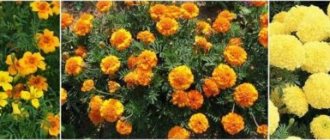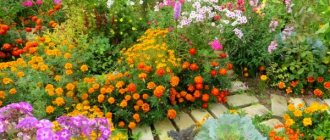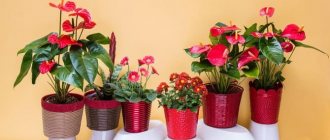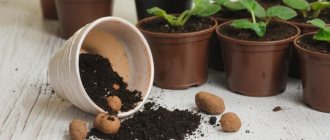Every spring, the main word for all gardeners is “seedlings.” And with the same regularity, questions related to it arise again and again - where to buy seedlings, what soil to plant in, what to feed, how to water, how much to add light, when and how to plant...
In this material we tried to collect answers to basic questions about seedlings, so to speak, general points and rules for growing high-quality and healthy seedlings at home.
So, a reminder for growing seedlings at home.
Rule 1
Buy seeds only from a trusted manufacturer, official specialty stores or garden centers. If you do not follow this rule and purchase seed material from a Chinese online store (at a kiosk among Snickers, from a random grandmother from a stall on the street, etc.), at best you will get non-germinating seeds or a grown plant of the wrong variety (species). , color, size). At worst, you risk re-infecting all neighboring seedlings, because it is not clear where the purchased seeds came from, how they were processed and how they were stored before getting to you.
- How sellers deceive us, or Plants that do not exist in nature
Rainbow rose, blue strawberry and lily tree - still dreaming of buying? Then our information is for you!
At a minimum, for preventive purposes, soak the suspicious seed in a strong solution of potassium permanganate, and then rinse with running water.
Preparing vegetable seedlings for transplanting into the ground
Hardening
When the time approaches to transplant the prepared seedlings to the garden bed, it is necessary to harden them. This way the plants adapt better and grow faster. At first, you can take the seedlings out onto the balcony, and when the threat of frost has passed, you can leave the boxes outside, but you will still have to wrap them in film at night. Hardening should begin 1-1.5 weeks before planting in open ground at the dacha.
Watering
Before planting, the plants need to be watered and then planted in holes, deepening the plantings to the 1st pair of leaves. The soil near the plant must be pressed tightly with your hands. When the seedlings take root and begin to grow, the first feeding with liquid fertilizer (for example, water with ash) will be required.
Rule 2
Most diseases of vegetable and flower crops are transmitted with planting material. Therefore, even reliably high-quality seeds, do not be too lazy to sort, pickle, soak and/or harden before planting in order to get rid of possible pathogens, enrich the seeds with microelements, improve their germination, and ensure smooth germination. The method and duration of treatment depend on the crop and age of the seeds.
Only pelleted and encrusted seed does not need processing.
- Preparing seeds for sowing: what do you need to remember?
Prepare seeds for sowing correctly!
Growing seedlings in “diapers”
Seedlings germinated in “snails” can be planted not only in glasses, but also in “diapers”. This method is also space and soil saving. In this case, ordinary packaging plastic bags are used as wrapping material.
Growing seedlings in “diapers”
Picking plants into “diapers” is performed using the technology given below.
Step 1. The plastic bag is spread on a tray. Prepare the soil - it should be moderately moist so that it does not crumble when squeezed in a fist.
Preparing the diaper bag
Step 2. Pour a tablespoon of soil onto one end of the “diaper”, closer to one edge. They level it out.
Soil on a picking bag
Step 3. A sprout taken from the “snail” is placed on top of the ground. To do this, the “snail” is slightly rolled out to free the root system along with the earthen lump. The sprout is placed so that the cotyledon leaves are above the edge of the film.
Sprout placement
Step 4. Cover the top of the sprout with another tablespoon of soil, trim it (the soil) so that it does not spill out when wrapping. The bottom edge is left free of soil to make it easier to roll up the film.
Backfilling the sprout with soil
Step 5. Wrap the film, carefully compacting the soil around the root system. The bottom is folded so that the soil does not spill out and water does not flow out.
Wrapping the film
Step 6. The soil on the surface is leveled, compacted and topped up if necessary.
Leveling and filling soil
Step 7. Seedlings in a “diaper” are placed in a container, at the bottom of which sawdust is poured to absorb excess moisture. If the film unrolls, you can secure it with an elastic band.
Placing seedlings in a container
Step 8. Water the seedlings at the root using a small watering can or rubber bulb. With this method of growing seedlings, it is better to fertilize with each watering, dissolving a small amount of fertilizer in the settled water.
Watering and care
You can grow not only picked seedlings in “diapers”, but also plants that do not tolerate picking well - cucumbers and zucchini, pumpkins, tribute and watermelons, as well as other vegetables and flowers with large seeds before planting in the ground. They are planted 2-3 seeds in pre-prepared “diapers”, watered and placed in a container, covered with a bag. After germination, the strongest sprout is left in each “diaper”.
Video – Picking peppers in “diapers”
The described general techniques for growing seedlings are suitable for almost all vegetable and flower crops; however, each plant needs a special regime and duration of cultivation, watering and fertilizing. A brief description of the agricultural technology for growing various crops is shown in the figure.
Conditions for growing vegetable seedlings
If you follow the planting dates and follow all care recommendations, you will be able to get strong and healthy seedlings that will quickly take root and produce a good harvest.
Rule 3
Take care in advance to properly prepare nutrient soil for sowing seeds. No, ordinary soil from a garden bed or soil mixture left over from replanting flowers will not work. Not only do seedlings require a completely different soil composition than an adult plant, but each crop also has its own preferences that will have to be taken into account.
Soil for seedlings can be purchased at the store if you trust the manufacturer (see rule 1), or you can prepare it yourself at home, it’s not difficult.
- Soil for seedlings - how to prepare the right mixture for young plants
Seedlings of tomatoes, peppers, eggplants, cucumbers and cabbage will be strong and healthy if grown in the correct substrate.
In any case, the prepared soil will have to be sifted and then disinfected thermally or chemically before sowing the seeds - you need healthy plants!
Growing seedlings in boxes and cups
Traditionally, seedlings are grown in seedling boxes, cups or cassettes filled with soil. There are other growing methods, which will be discussed below.
Growing seedlings in cassettes
Prices for seedling boxes
seedling boxes
Soil preparation
Healthy and fertile soil is the key to high-quality seedlings that can produce strong and healthy plants and a good harvest.
Good quality soil is a must:
- loose, breathable;
- moisturizes well and retains moisture;
- does not contain weed seeds;
- treated against bacteria, viruses and fungi;
- balanced in the content of macro- and microelements.
Most high-quality commercial soils for seedlings meet these requirements. They are treated with steam and fungicides, after which they become sterile. To increase fertility, it is recommended to water them with a solution of EM preparations (Baikal EM-1, Siyanie-EM and analogues) before planting.
Microbiological fertilizer "Baikal EM-1" for high yields
You can make your own soil mixture by preparing it in the fall. When sowing seeds in the ground, it is important to choose a composition suitable for a specific crop. Plants have different requirements for soil nutrition, structure and chemical composition. Soil mixtures suitable for different crops are described in Table 2.
Table 2. Soil mixtures for different crops.
| Cultures | Nutrient Soil Components |
| Solanaceae | Humus, garden soil, sand in a ratio of 2:1:1, add 1 tbsp to 1 liter of mixture. spoon of wood ash |
| Melons | Garden soil, humus, sawdust in a ratio of 2:1:1 |
| Cruciferous | Humus, garden soil in a 1:1 ratio, add 1 tbsp to 1 liter of mixture. spoon of ash and 1 teaspoon of slaked lime |
| Onions, herbs | Humus, garden soil, sand in a ratio of 2:1:1, add 1 tbsp to 1 liter of mixture. spoon of wood ash |
| Strawberries, flowers | Peat, garden soil, sawdust, humus in the ratio 5:2:1:2 |
The components are mixed in a large container until homogeneous, after which heat treatment is carried out.
Preparing the soil mixture
You can do this in several ways:
- heat at a temperature of +60-70 degrees for 1-2 hours, for example, in the oven;
- heat to high temperature in a metal bucket or basin, for example, over a fire;
- pour a hot solution of potassium permanganate.
After heat treatment, the soil mixture is cooled, placed in bags and stored.
Instead of heat treatment, you can use freezing - it helps get rid of insects and their larvae, and also sharply reduces the germination of weed seeds. At the same time, it is important to take garden soil from those areas of the garden where crops related to seedlings have not been grown for 4-5 years.
Note! It is not recommended to take soil from the greenhouse - there are almost always spores of fungal diseases that can destroy all seedlings immediately after germination!
Prices for Baikal EM-1
Baikal EM-1
Video - Preparing soil for seedlings
Containers for seedlings
To grow seedlings, use special cups, cassettes and boxes, as well as any available containers of a suitable size. The preferred material is smooth plastic - it is easy to wash and disinfect, it has low thermal conductivity and does not rot.
Seedling box
The sizes of common boxes for seedlings can be any, they depend on the number of seeds sown. The depth should be sufficient to prevent the soil from drying out. In boxes, seedlings of vegetable crops are successfully grown before picking, as well as onions, celery and flowers before planting in the ground - they tolerate replanting well and quickly take root even with slight disruption of the root system.
Cassettes for seedlings
DIY seedling boxes
What exactly you plan to grow tomatoes, peppers, eggplants, other vegetable crops or garden flowers in is of great importance. It will be great if you can make seedling boxes with your own hands.
Crops with sensitive root systems are best grown in separate containers. These include peppers and eggplants, pickled tomatoes, cucumbers and all melons, as well as some types of flowers.
The volume of seedling cups and cassettes is selected depending on the crop:
- tomatoes, peppers and eggplants – 200-350 ml;
- cucumbers, watermelons and melons – 200-300 ml;
- pumpkins, zucchini, squash - 250-400 ml;
- spicy herbs, leeks and nigella – 70-150 ml;
- flowers with small seeds – 100-200 ml;
- flowers with large seeds - 200-300 ml.
Disposable glasses are often used as seedling containers. They are inexpensive, have different volumes and convenient shapes. However, the durability of such cups is low; they usually only last for one season. When using disposable cups, it is necessary to make drainage holes in their bottoms.
Seedlings in disposable cups
Another option is peat cups. They are made from a pressed peat mixture that decomposes in the ground in one season. The seedlings are planted directly in the glass without damaging its roots. Peat cups are usually used for plants with a delicate root system - peppers, cucumbers, pumpkins.
Peat pots and cups
Note! The soil in peat cups dries out faster, and when overfilled, their walls get wet and collapse. Therefore, watering should be regular, but moderate.
Video - Features of planting seedlings in peat cups in the ground
You can also use dense bags of the same size for seedlings, for example, milk bags. They are convenient because you can roll up the bag when planting, and as the seedlings grow, gradually roll it out and add soil. This technique is useful for plants that grow additional roots when buried - for example, tomatoes or flowers.
Seedlings in bags
It is better to germinate seeds under film or glass - this creates a greenhouse effect, the soil remains moist and warm, and sprouts appear faster. Mini-greenhouses with removable transparent lids are convenient for germinating seeds. You can make a greenhouse yourself from transparent disposable containers.
Mini greenhouse for seedlings
Before planting seeds and picking, reusable seedling containers must be washed with warm water and laundry soap and rinsed with clean water. When using wooden boxes, it is recommended to disinfect them with a solution of copper sulfate or bleach.
Seed preparation
Pre-sowing preparation allows you to reject empty seeds, disinfect them and speed up germination. Seed preparation for different crops is carried out in different ways; the main steps required for all garden crops are described below.
Step 1. To select the largest and fullest seeds, calibration is carried out. You can make it at home in two ways - manually and by soaking in a saline solution. The first method is suitable for plants with large seeds - pumpkins, zucchini, cucumbers. For calibration in saline solution, medium and small seeds are more suitable (such as tomatoes, peppers, eggplants, onions and most flowers).
The seeds are manually calibrated using a checkered sheet or ruler. Place the seeds on a flat surface or a sheet of paper and wipe off the largest, smoothest and densest ones. All seeds that are irregularly shaped, as well as empty and too small, are discarded.
Calibrating seeds using a ruler
To calibrate in a solution, stir 1 tablespoon of table salt in a glass of warm water, then immerse the seeds there for 15-30 minutes. The floating seeds are removed, and those that have settled to the bottom are washed and dried.
Calibration of seeds in a solution of table salt
Note! Viable seeds can also float if they are dry. If there are a lot of such seeds, you need to check their germination in a small batch.
Step 2. Seed disinfection is carried out in several stages. For bacterial infections, seeds are treated with a solution of potassium permanganate at a concentration of 1 g per 1 liter of water. Stir the crystals until completely dissolved and pour the seeds into a small bowl. Keep in the solution for 20 minutes.
Treatment in a solution of potassium permanganate
You can use a 3% hydrogen peroxide solution. It is heated in a water bath to a temperature of +38-40 degrees and the seeds are poured in for 10 minutes.
Processing in hydrogen peroxide
Step 3. Treatment against fungal infections is the second stage of seed disinfection. It is carried out in fungicides - antifungal drugs. They can be either in the form of a solution or in powder. At home, the most commonly used drug of natural origin is Fitosporin-M. It is available in powder, paste or liquid form. Dilute the drug as indicated on the package and pour in the seeds for 2-3 hours.
Treatment of seeds with Fitosporin-M
Step 4. Surface treatment does not help against viral diseases, so the seeds are heated with dry heat for 5-7 days, hanging in fabric bags on a radiator.
Warming up the seeds
For accelerated processing, you can place the seeds in water at a temperature of +50-60 degrees for 1-2 hours. It is more convenient to do this in a thermos, where the water does not cool down longer.
Step 5. Immediately before planting, the seeds are treated in a solution of growth stimulants, these include Epin, Zircon, solutions of potassium and sodium humates, aloe juice and other natural preparations. The solution is prepared according to the recommendations on the package and poured into the seeds. Treatment time depends on the drug and can be 1-24 hours.
Soaking in stimulants
Step 6. After treatment with stimulants, the seeds are soaked in water and left in a warm place to swell. Soaking is necessary to soften the seed shell and speed up its germination.
Soaking time depends on the size and density of the seeds:
- tomatoes, peppers, eggplants – 3-4 hours;
- cabbage – 3-4 hours;
- cucumbers, melons – 12 hours;
- leeks and chives – 12 hours;
- pumpkin, zucchini, watermelon - 24 hours.
This process can be accelerated by bubbling - treating seeds in water with air bubbles. For bubbling, an aquarium compressor is used, its tube is lowered into a jar with soaked seeds and the device is turned on. The soaking time can be halved. It is better to place the seeds in gauze bags.
Bubbling seeds
Step 7. After soaking, the seeds can be planted in the ground or germinated by wrapping them in a damp soft cloth or gauze. The seeds are germinated at the temperature recommended for this crop until they peck and sprouts appear. The fabric should be constantly damp. It is important not to miss this moment and not to allow the roots to grow into the tissue - it will be difficult to get the seeds out of there without damaging the roots.
Germination of seeds
Germination can be combined with hardening. Seeds wrapped in cloth on a saucer are placed in the refrigerator at a temperature of +2-4 degrees overnight. Seeds of plants intended for planting in open ground can be subjected to cyclic temperature changes: put in the refrigerator at night and kept at room temperature during the day. In this mode, they are hardened for two or three days, after which they are removed to a warm place until germination.
Hardening of seeds
Note! Seeds with fragile roots, for example, cucumbers and all pumpkins, are best planted immediately after pecking.
Sowing and germination of seeds
Crops that lend themselves well to picking can be sown in common seedling boxes for germination; these include:
- tomatoes and eggplants;
- leeks and chives;
- all types of cabbage;
- flowers with medium-sized seeds - marigolds, asters, zinnias, dahlias.
Aster seeds
Plants with a delicate and fragile root system do not tolerate picking; it is better to immediately plant them in separate cups or seedling trays of the appropriate size. As they grow, they are transferred to larger individual containers.
These crops include:
- cucumbers and all pumpkin varieties;
- sweet and hot peppers;
- roots;
- flowers with large seeds.
Step 1. Seedling containers are filled with soil suitable for the given crop. Lightly compact it and make grooves or indentations. Water with settled water, and if soil disinfection is required, with a weak solution of potassium permanganate. Allow water to soak in and moisten the soil well.
Preparation of seedling boxes, soil and seeds
Step 2. Pre-treated seeds are placed into the recesses with your hands or using tweezers; small seeds are conveniently placed with a toothpick.
Sowing seeds
Step 3. Sprinkle the grooves or depressions on top with a layer of soil. There is no need to water additionally - the moisture absorbed into the soil will be enough to nourish the roots, while at the same time air access to the seeds will be ensured through the top loose layer.
Filling the seeds with soil
Step 4. Cover the containers with cling film and place in a warm place. Light is not needed for seed germination, with the exception of small flower seeds that are sown superficially, without covering them with soil.
Box with seedlings under film
Step 5. Immediately after the loops appear, you need to remove the film and place the containers with seedlings in a well-lit place. It is advisable to provide additional lighting with fluorescent or LED lamps. In the first days, in the phase of cotyledon leaves, seedlings can be illuminated for 16-18 hours a day - this will help them not to stretch out. After the appearance of real leaves, daylight hours are gradually reduced to the norm for this crop.
Additional illumination of seedlings
Note! If the seedlings have stretched out in the cotyledon leaf phase, it is necessary to add soil to the level of the cotyledons.
Picking and transshipment
Seedlings are usually picked at the stage of 2-3 true leaves. Later, the root system grows greatly and is damaged during picking. Transshipment of seedlings from glasses and seedling cassettes into larger containers is carried out as the root system grows.
Step 1. Prepare seedling cups or cassettes and fill them with pre-prepared soil approximately 2/3 when picking and 1/2 when transferring. Water the soil and allow it to be evenly moistened. If necessary, disinfect with a solution of potassium permanganate.
Preparing seedlings with soil
Step 2. Gently pry up the sprout with a small spatula or wooden stick. They are taken out together with the earthen lump, being careful not to damage the root system. It is better to hold the sprout by the leaves, and not by the stem - if the leaves are damaged, the plant will quickly recover, and a broken stem will lead to death. For tomatoes, cabbage and onions, pinch off the central root by 1/3.
Removing a sprout from the ground
Step 3. A depression is made in the soil along the length and width of the earthen clod. Carefully place the sprout there and add soil. Compact and lightly water. When planting tomatoes, cabbage and cucumbers, the sprout is buried down to the cotyledons; peppers and eggplants are not buried.
Recess for planting a sprout
Step 4. When transferring it into a larger container, carefully remove the seedling, place it in a larger glass and add soil around it. If necessary, deepen. Lightly water and compact the soil.
Transshipment of seedlings when growing in cassettes
Step 5. In the first few days after transshipment and picking, the plants need to be provided with diffused light and moderately moist soil. As soon as the root system adapts, the seedlings will begin to grow.
Seedlings after picking
Note! Some flowers, for example, lobelia, plant several seedlings into one seedling glass.
Prices for potassium permanganate
potassium permanganate
Watering seedlings
A lot depends on proper watering - when the earthen clod dries out, the seedlings stop growing and wither, and if overwatered, they can develop fungal infections. It is better to water the seedlings with soft water - rain, melt or settled water - with the addition of a small amount of humates.
Getting melt water at home is quite simple: pour tap water into any container, let it sit for 24 hours and put it in the freezer. The water begins to freeze from the edges of the container. As soon as it freezes by about 2/3 of the volume, it is taken out, the unfrozen part of the water is drained - it contains all the dissolved elements. The remaining ice is thawed and used to water the seedlings.
Obtaining melt water
In the first stage of cultivation, before the true leaves appear, the seedlings are watered very carefully so as not to damage the fragile sprouts. This can be done from a small watering can or spray bottle set to a small spray angle. The seedlings are watered at the root.
Watering seedlings from a watering can
After picking, as the vegetative mass develops, the seedlings are watered less frequently, but more abundantly, until the earthen clod is wetted. It is important to avoid stagnation of water and allow the top layer of soil to dry out between waterings.
Watering seedlings after picking
Note! It is not advisable to water the seedlings for the first 3-5 days after picking! Frail roots may rot.
Fertilizing seedlings
Fertilizing is carried out as planned or when signs of nutrient deficiency appear. Before the true leaves appear, the sprout uses up the supply of nutrients contained in the seed. After the first true leaf appears, the active development of the root system begins and the plant can absorb micro- and macroelements from the soil.
There are many recipes for fertilizers containing organic and mineral substances, but the easiest way is to buy a complex fertilizer for seedlings. It can be both universal and specially adapted to the needs of different cultures.
Complex fertilizers for seedlings
Fertilizers for seedlings are available in various forms:
- liquid concentrate;
- water-soluble granules;
- powder.
A good fertilizer for seedlings contains:
- nitrogen (N);
- potassium (K);
- phosphorus (P);
- trace elements in chelated form.
The exact dosage and schedule for feeding seedlings is always indicated by the fertilizer manufacturer on the packaging. If there is no such information on the package or bottle of fertilizer, it is better to refrain from using it.
Before picking, seedlings usually have enough nutrients contained in the fertile soil. 7-10 days after picking or transplanting, you can start feeding. Fertilizer in dissolved form is applied with morning watering. If the earthen clod dries out too much, you must first moisten it moderately with clean water, and only then apply fertilizing. The second and subsequent fertilizing with complex fertilizer is carried out 7-10 days after the previous one until the seedlings are planted.
Extraordinary feeding is needed when obvious signs of a lack of elements appear. They can be identified by the appearance of the seedlings.
Signs of a lack of micro- and macroelements
The reasons for the lack of elements, as well as the methods for replenishing them, are different; they are described in the table shown in the figure. Sometimes changing the lighting or temperature is enough for the plant to absorb nutrients from the soil.
Causes and signs of micronutrient deficiency
Note! It is undesirable to use organic fertilizers to fertilize young seedlings - their composition is unstable, so it is difficult to calculate the dosage.
Fertilizer prices
fertilizers
Rule 4
The rule of absolute cleanliness in growing seedlings applies not only to the soil - if possible, everything should be disinfected.
Namely:
- containers for growing seedlings from any material (pots, boxes, cassettes, cups, etc.);
- tools that are used for loosening, watering, picking and other manipulations with seedlings;
- “place of residence” of seedlings and nearby surfaces (table, window sill, wall, window).
The last point is especially relevant for premises where houseplants are grown, which can easily become a source of infection of young and immature seedlings.
For disinfection, you can use the simplest means, for example, a weak solution of potassium permanganate.
Gardening a vegetable garden on a windowsill in winter is easy!
- Aesthetics.
It’s not for nothing that green is considered a calming color, and in the summer, when the foliage on the trees and the grass on the lawn are at their best, no one would even think of complaining about its abundance and annoyingness. So, a few bushes of greenery or, better yet, flowering and fruiting plants will at least please the eye.
- Practicality.
Rationalists and skeptics, when choosing between geranium and parsley, will certainly give preference to the latter - not only beautiful, but also tasty.
- Saving.
Greens and fresh vegetables, which are also quite possible to grow in your own window in February, are expensive in winter, but the quality and taste, however, leave much to be desired. It’s either the fruits of one’s own labors—tasty, free, and a pleasure in the process and in the result.
- A wonderful time.
How often, especially women, on cold winter days, their hands itch with the desire to do or make something. Some people know how to knit, some know how to sew, and others may well discover in themselves an extraordinary experimental gardener who, no, no, and, as soon as it gets warmer, will move from the windowsill to a real garden.
- No difficulties.
No matter how it may seem to a novice gardener that growing plants, and especially food, is the lot of a select few, there is really nothing difficult about regularly harvesting the same green onion. On the contrary, it may turn out to be easier and more interesting than growing even the most unpretentious indoor plants.
In order to start planting a vegetable garden on the windowsill you will need the following:
- Containers.
The most reliable ones are plastic or clay. Each type of plant should have its own container.
- Priming.
It’s easier and better for those who decide to start gardening for the first time to buy soil in a specialized store.
- Drainage.
The drainage can be purchased gravel, or, say, broken bricks or small pebbles from a nearby pond.
- White spectrum fluorescent lamps.
Absolutely necessary, especially for the northern winter, to extend daylight hours for plants to at least 13-15 hours.
If you have the listed minimum equipment and a great desire to get results and enjoy the process, harvesting the winter harvest will be inevitable.
Rule 5
Follow the timing of planting seeds for seedlings so that the seedlings develop well, do not stretch, do not overgrow, and are in the best shape by the time of planting. This postulate is especially relevant for plants intended for planting in open ground.
It would seem logical - the sooner you sow the seeds, the sooner the long-awaited harvest will ripen. However, do not forget how capricious the weather is in our latitudes - by the time of the planned landing, the ground may simply not warm up enough for the landing to be possible at all (if, in principle, there is no snow). Follow the long-term weather forecast, study the climatic conditions of past years in your region.
When calculating the sowing time, take into account the characteristics of the plant and the specific variety, the characteristics of the garden plot, the conditions for further growing the plants and your capabilities. For example, if the seeds are sown too early, the seedlings will have to be illuminated for the first time - are you technically ready for this?
It is also important not to overcook the seedlings. The older your plants are, the worse they will tolerate transplantation and the longer they will take root in their new location.
- When to sow seeds for seedlings - calculate the optimal timing
The timing of sowing seeds for seedlings - how to determine for different crops? Let's figure it out together.
Caring for cucumber seedlings at home
If two seeds sown in containers both sprout, remove the weaker sprout. Just don’t pull it out of the ground (this will damage the roots of the second seedling), but simply cut it off at the very soil level. Water the seedlings regularly, every 1-2 days (it is better to do this in the morning), and only with warm water. Also make sure that there is no draft in the room - this can destroy the seedlings.
To prevent the seedlings from stretching out and being stocky, provide them with good lighting (if necessary, add additional light to the plants on cloudy days) and add soil 1-2 times during cultivation (when the seedlings begin to stretch out). When the plants have 2 true leaves, they can be fed with a solution of nitrophoska or nitroammophoska (1 tsp per 1 liter of water).
Some gardeners use magnetized water to water seedlings. It’s very simple to get it - just put a piece of magnet in a watering can, fill it with water and let it stand for a while.
Rule 6
The health of future seedlings depends not only on a properly selected substrate and well-prepared seeds, but also on a well-chosen container for sowing. Currently, the range of containers is large, you can choose the right one for each crop - pots made of plastic or pressed rice flour, boxes, cups, cassettes, peat tablets and cubes...
Find out in advance whether the crop you are growing needs picking, how the seedlings of a particular plant will tolerate transplantation, what size the seeds are and how the root system of the seedlings will develop in the future.
The type, size and volume of containers you plan to use for future seedlings depend on all of the above factors.
- What to grow seedlings in - choosing the right container
Let’s take all the containers apart “piece by piece” and tell you why plants don’t “like” peat pots and what dangers seedling cassettes pose.
The time interval from sowing seeds of some vegetables to planting seedlings in open ground
Eggplants and peppers/medium-growing tomatoes/standard tomatoes/tall tomatoes, respectively: 2 months/40-45 days/50 days/2 months.
Watermelon/pumpkin/cucumbers - 20 days in advance, strawberries (strawberries) - 2 months in advance.
Celery/onion, respectively: 2 months/1.5-2 months.
Early varieties of tomatoes
They sprout approximately a week after sowing. Therefore, we plant them in open ground after a month and a half. A favorable period for planting tomatoes in the garden is the beginning of June. If planted in a greenhouse, this should be done in mid-May.
Mid-season and late varieties of tomatoes
Sprouts sprout 6 days after sowing the seeds, but they should be planted in a permanent place no earlier than after 1-2 months. This period occurs at the beginning of June, so sowing seeds should be much earlier than early varieties of tomatoes.
cucumbers
Their “upstart” sprouts appear within 2-3 days. After a month, the plants are ready to be transplanted into the garden. They are transferred to the greenhouse at the end of May, and to the garden bed in June.
Pumpkin
Pumpkin, squash and zucchini, close relatives of cucumbers, sprout 4-5 days after sowing as seedlings. A month later they are ready to be planted in open ground.
When transferring cucumbers, pumpkins, zucchini and squash, you cannot damage their delicate root system, therefore, you first need to moisten the soil well, and then transfer the plants into the prepared hole with a large lump of earth.
Eggplant
They take quite a long time to hatch. You can wait for the dark-skinned seedlings to emerge only after 2 weeks. And they should be planted in the garden only after 60 days, in the month of June.
Bell pepper
The same is true with this vegetable. Pepper seedlings develop quite slowly, so they need to be sown at the end of February in order to plant them in the garden after 3 months. Under good conditions, seedlings may even bloom before transplanting into the ground.
Salad
Those who like to grow it in seedlings can be advised to sow the seeds at the end of May, and at the end of June transfer them to the garden bed.
Rule 7
Sowing seeds also needs to be done correctly - keep in mind that seeds of different crops, due to differences in size or developmental characteristics, may require different methods, density and depth of sowing.
Usually, especially small seeds are simply laid out on the surface of the substrate and sprinkled with water from a spray bottle. In addition, for ease of sowing, they are often mixed with fine dry sand. Medium-sized seeds are planted in small grooves, the size of which is determined by this same size (the thickness of the top layer should be no more than twice the size of the seed), and lightly sprinkled with soil. Large seeds can therefore be planted deeper.
It is also important to observe the seed planting density determined by agricultural technology for each specific crop, because in an overly thickened planting, seedlings will interfere with each other and compete for food, moisture and light.
Seedlings: care at home
Until the shoots appear, light is not needed. During this period, crops most need high temperature and humidity - this promotes better seed germination.
To ensure such conditions, place the containers in the warmest place in the apartment and cover them with plastic film, glass or other available material. To ensure high humidity, spray the substrate daily with a spray bottle. But don’t overdo it - the soil in the container should not float.
| Culture | Temperature before emergence (°C) |
| Tomato | 20-25 |
| Pepper | 25-30 |
| Eggplant | 25-30 |
| Cabbage | 18-20 |
| Cucumber | 25-28 |
Rule 8
Do not forget about the temperature regime for growing seedlings, which lays the foundation for the resistance of grown crops to diseases and adverse weather conditions.
Although it is clear that excessively high and excessively low temperatures are equally harmful to seedlings, the same temperature regime is not always suitable for seedlings of different crops for comfortable development.
Some plants (tomatoes, eggplants, peppers) are heat-loving and require a daytime temperature in the range of 22-25°C, and a night temperature of at least 18°C. Others (potatoes, celery, lettuce) are moderately demanding of heat; 14-18°C during the day and 12-14°C at night are enough for them. Still others are generally cold-resistant (all types of cabbage) and tolerate night temperatures even within 6°C, and during the day they need 13-16°C.
- What should be the temperature for growing seedlings?
Why can’t cabbage and peppers be kept in the same room? Find out everything about the temperature for growing seedlings of your favorite plants.
What crops are grown by seedlings
Most heat-loving plants with a long flowering and fruiting period are grown in seedlings. In the conditions of the middle zone, such plants do not have time to fully grow, bloom and bear fruit during the warm season.
Heat-loving plants grown by seedlings include:
- peppers, eggplants and tomatoes;
- cucumbers and zucchini;
- melons - pumpkin, watermelon and melon;
- varietal potatoes from seeds.
Warm-season crops grown by seedlings
To obtain an early harvest, all types of cabbage are grown through seedlings - white and red cabbage, cauliflower, broccoli, Brussels sprouts and kohlrabi. You can grow seedlings and root vegetables - beets, radishes and daikon.
Vegetables for seedlings
Biennial and perennial plants are grown through seedlings to achieve flowering or fruiting in one year. Cold-resistant plants grown in seedlings include nigella and leeks, celery, and parsnips. Some herbs are also sown on seedlings - basil, lemon balm, thyme and oregano.
Onions and herbs for seedlings
Garden strawberries from seeds are also grown by seedlings, and they are sown at the beginning of winter. By summer, they get developed bushes that quickly take root and even manage to bear the first berries. Flowers with a long development period are also better to plant as seedlings - this way they will bloom in early summer.
Strawberry seedlings
Prices for vegetable seeds
seeds vegetables
Rule 9
Provide your seedlings with optimal daylight hours (lighting) to bring growth conditions closer to natural. After all, by sowing seeds in February, we, strictly speaking, are trying to circumvent the laws of nature.
If the sowing time is quite late, the seedlings can get by with natural sunlight - you just need to provide them with a place on a bright windowsill. In case of early sowing of seeds, you will have to purchase special phytolamps and add additional illumination to the seedlings. In general, in our not very sunny climate, it is useful to have at least one such lamp “just in case” for every gardener who wants to produce strong seedlings.
Remember that even with the purchase of a phytolamp, you will have to understand the nuances - after all, at different stages of development, seedlings require lighting regimes of different durations and intensity. So study the manufacturers’ instructions and agrotechnical “machinery parts”.
- Lighting for seedlings at home
Do seedlings grown on a windowsill need additional lighting? What are phytolamps, how to choose them and use them correctly?
Shelf life and endurance
After most vegetables are collected from the garden beds, they are stored for a long time, so it is important that they last all winter and retain their taste. Plants must be resistant to temperature fluctuations and withstand the vagaries of nature.
As a rule, varieties with high hardiness do not contain as many useful substances as more capricious ones. Therefore, it is important to find a “golden mean” and focus on the climate in the region or the long-term weather forecast.
Good lighting, frequent watering, correct temperature conditions have a great influence on growth activity, development of the root system and future yield of seedlings grown from seeds at home.
Rule 10
Do not overdry or overwater the seedlings; make sure the soil is always slightly moist. In the first stages of growth, excessive watering and stagnation of water are especially harmful to seedlings, and later problems can be caused by insufficient, superficial watering of plants.
Seedlings of any crop are watered when the top layer of soil dries out. Before emergence, the soil is moistened with a spray bottle and covered with glass or film to create a special microclimate. In the first days after the emergence of seedlings, the shelter is removed, and the seedlings are watered by spraying water from a fine spray bottle or using a pipette under the root - so as not to damage the still immature plants. After 2-3 true leaves appear, the seedlings’ need for water increases, so you need to ensure that the liquid reaches the lowest layer of soil. At this stage, you can practice watering from below (into the pan) to stimulate the formation of the root system.
Pay attention to the water you water the seedlings with. It must be settled or filtered and must be warm (about 20°C).
- How to properly water seedlings on a windowsill, in a greenhouse and in the ground
Everything you wanted to know about watering vegetable seedlings.
Features of growing seedlings from seeds (step by step)
- Thickening of crops . It is important to consider sowing agricultural technology individually for each crop. There is no need to thicken the seedlings too much, because each plant should receive the sun, water and nutrients equally. Saving space can lead to weak, elongated and diseased seedlings, with roots intertwined, which makes picking difficult. Such seedlings will definitely not provide the gardener with a good harvest.
- Watering . After sowing, it is better not to water the seeds so that they do not sink deeper into the soil than necessary. The soil is well moistened before sowing, and if there is a need for watering after, then it is better to use a spray bottle.
- Feeding . To stimulate healthy seedling growth, do not forget about special fertilizing. This is especially necessary for seedlings grown in small containers. Seedlings are fertilized with ammonium nitrate, potassium sulfate or superphosphate. Before applying fertilizer, it is important to protect the weak root system of young plants by irrigating them with plain water from a spray bottle. The volume and frequency of fertilizing can be found in the description of the plant variety on the packaging.
- Diseases . With improper care or poor pre-sowing treatment, seedlings can be affected by various diseases. Often young plants suffer from blackleg and root rot. In this case, it is better to prevent the disease from occurring than to treat it. For additional protection, seedlings are treated with special means.
General recommendations that will help you get high-quality seedlings
To obtain high-quality seedlings, it is important to strictly observe certain conditions. Seeds need a lot of sun energy, heat and moisture in order for them to germinate well.
Lighting
For stable growth and development of plants, daylight hours should last at least 12-14 hours a day. Early seedlings will have to be additionally illuminated with a special lamp. To ensure that the crops receive more light, the dishes are moved to the windowsill on the south side of the house.
Humidity level
Seeds need a constant level of moisture in order for them to germinate. Therefore, after sowing, the dishes are covered with film and mini-greenhouse conditions are created to maintain the necessary humidity and prevent the substrate from drying out. The film needs to be removed briefly every day to air it out. After all the shoots appear, the shelter is removed for good.
Of course, each plant has its own requirements for humidity and watering, but in order not to ruin young seedlings, it is recommended to moisten the soil as the top layer of the substrate dries.
It is better to irrigate the soil from a sprayer from above and pour water into the pan from below. It is important that the contents of the pot always remain moist, but you should avoid excess moisture, as this can lead to rotting of the roots. Water the seedlings with soft, settled water no colder than 20-24 degrees.
Temperature
Low temperatures will slow down germination and growth of seedlings. If a container or tray with crops is on a cold windowsill, then it is better to place a stand under the dishes. If possible, you can use an electric heating pad, which is also placed under the dishes. The soil temperature should be approximately 21 degrees.
Important! When the seedlings just begin to appear, it is necessary to maintain 25-27 degrees of heat in the room, and when all the seeds have sprouted, the temperature can be lowered to 20 degrees.
For beginners, growing seeds at home (planting, calculating the favorable time and many other nuances) may seem like a complicated science, but this is absolutely not the case. It is important to approach the process with ease and enjoy working with plants.
Author of the article: Skorobogataya Tamara Dmitrievna
Tags: seedlings, seeds
- Related Posts
- How to plant seeds in the ground correctly: general rules for growing seedlings
- Beautiful geranium - growing and care at home (photo)
- Secrets of growing cucumbers: planting, feeding, care
« Previous entry
Rule 11
Do not forget that seedlings require regular feeding - even the richest soil in composition is not able to provide it with nutrients throughout the entire growth period.
When choosing fertilizer for seedlings (and today there are many of them, both complex and simple - to suit any needs), pay attention to the appropriate markings on the packaging, because The concentration of the active substance in fertilizers for adult and young plants can differ significantly.
The first application of fertilizers is carried out after the plant has taken root; the optimal time to start fertilizing is after picking. Regardless of the type of fertilizer, the interval for fertilizing seedlings should be at least a week. In order for the plant to develop harmoniously, alternate feeding with mineral and organic substances with the application of fertilizers for seedling growth.
Fertilize in the morning during cloudy or cloudy weather. Apply the fertilizer solution at the root, making sure that it does not get on the tender leaves and stems of the seedlings, otherwise it will lead to burns.
- Fertilizers for seedlings - which ones to choose and how to feed the plants
From nitrogen to phosphorus or, Everything you need to know about feeding seedlings.
Growing seedlings in "snails"
One of the original ways to get strong seedlings ready for picking is to grow them in “snails” made of foamed polyethylene. The latter is used as a substrate for laminate or as film thermal insulation. Strips of this material are rolled up along with a thin layer of soil in which the seeds are placed. As a result, a “snail” is formed, inside which excellent conditions are created for the development of seedlings.
Growing seedlings in "snails"
Advantages of the method:
- saving space and soil;
- optimal conditions for seed germination;
- easy picking without damaging the roots.
Flaws:
- long process of sowing seeds;
- If the sprouts are not transplanted in time, they may die.
In this way, you can germinate most garden crops - nightshades, all types of cabbage and lettuce, as well as root vegetables. The “snail” is also suitable for germinating medium-sized flower seeds. The preparation of soil and seeds is carried out using the usual technology described above.
Step 1. Foamed polyethylene is cut into strips about 50 cm long and 10-12 cm wide. Lay out on a tray with one end facing you.
Laminate backing strips
Step 2. Pour a few tablespoons of moderately moistened soil onto one end of the strip and level it.
Laying out the soil on the substrate
Step 3. Place the prepared seeds at a distance of 2-3 cm from one edge. The distance between the seeds is 1-2 cm.
Sowing seeds
Step 4. Carefully begin to roll the tape from the end. Add the next portion of soil and sow the seeds. This continues until the end of the tape.
Formation of the "snail"
Step 5. The rolled up “snail” is secured with a rubber band. Place in a container with a depth of at least half its (“snail”) height. The seeds should be at the top edge of the “snail”.
Securing the snail
Step 6. Well moisten the soil inside the “snail” using a spray bottle. In the future, watering can be carried out in the container - the moistened soil itself will absorb moisture.
Watering
Step 7. Place a regular plastic bag on the container with the “snail” and tie it to create greenhouse conditions inside. Place in a warm, bright place until the seeds germinate. Once a day, open the bag for ventilation.
Creating greenhouse conditions
Step 8. Seed germination in “snails” usually occurs faster than in soil, due to stable temperature and humidity. It is necessary to monitor the appearance of loops in order to immediately place the seedlings in the most illuminated place.
Germination of seeds
Step 9. After germination until two true leaves appear, caring for seedlings does not differ from conventional technology. Due to the small amount of soil, the seedlings may not have enough nutrition, so add a little complex or humic seedling fertilizer to the water for irrigation, approximately 20% of the concentration recommended for feeding.
Sprouts ready for picking
Step 10. When two true leaves appear on the sprouts, the “snail” is rolled out, the strongest seedlings are selected and dropped into cups using the usual technology or into “diapers” - we will discuss them below.
Picking seedlings from “snails”
Video - Growing seedlings in “snails”
Rule 12
Decide on picking seedlings - some crops need it vitally, others can easily do without it and, moreover, this procedure is extremely painful. Recently, the theory that all mechanical manipulations with seedlings should be minimized in order to avoid unnecessary injury has become increasingly widespread among gardeners.
If you are still planning to pick, remember that transplanting seedlings from a common container into separate containers is usually carried out at the stage of 1-2 true leaves (the older the plant, the worse it tolerates picking). All weak, crooked, pale plants are removed, leaving the strongest and most beautiful ones.
For the first 5-6 days after picking, the seedlings are not watered so that the plant takes root better (the roots will stretch and grow in search of moisture).
- Picking seedlings - what is it and why is it needed?
To dive or not, what crops to dive, what is better - picking or transshipment... And these questions haunt you?
Caring for seedlings after germination
As soon as the first loops of seedlings appear, the containers with seedlings should be moved to a more illuminated and cooler place (with a temperature no higher than 17°C). If the weather permits, they, for example, can be placed on an insulated balcony or loggia. Under such conditions, the growth of the above-ground parts of plants stops and the root system begins to develop. After 5-7 days, the containers with the crops are again transferred to a warm place.
| Culture | Temperature for 5-7 days after germination (°C) | Subsequent temperature (°C) | |||
| Day | Night | Sunny | Mainly cloudy | Night | |
| Tomato | 12-16 | 8-10 | 20-26 | 17-20 | 8-10 |
| Pepper | 13-16 | 8-10 | 20-27 | 17-20 | 10-13 |
| Eggplant | 13-16 | 8-10 | 20-27 | 17-20 | 10-13 |
| Cabbage | 10-12 | 6-10 | 14-18 | 12-16 | 6-10 |
| Cucumber | 15-17 | 12-14 | 19-20 | 17-19 | 12-14 |
It is not recommended to water the seedlings for the first 2-4 days after emergence. Subsequently, tomato seedlings are watered rarely (once a week in the morning), but abundantly. 15-20 days after emergence, the plants are planted in separate containers, deepened to the cotyledon leaves.
8-12 days after picking, the first feeding . An infusion of bird droppings is best suited for this purpose. To prepare it, dry litter (you can buy it at a garden center) is diluted in hot water in a ratio of 1:20 and left for 2 hours. Then the infusion is filtered and the seedlings are fed with it after the next watering.
The second feeding is carried out 2-3 weeks after the first. But this time they use complex fertilizers - Kemira-universal, Mortar, Rost-II or nitrophoska (1 tsp per 5 liters of water).
To protect against diseases, it is recommended to spray tomato seedlings every week with a milk solution (0.5 cups of skim milk diluted in 1 liter of water). This will protect the plants from viral diseases.
Rule 13
Do not allow the seedlings to be pulled out. An elongated, and therefore weak and fragile plant may die or not produce a good harvest in the future.
Such a sad outcome can be caused by sowing seeds too early, lack of lighting, incorrect temperature conditions, and even excess moisture or fertilizer - which is why it is so important to follow all the rules described above for caring for seedlings.
If trouble has already happened, try to minimize the consequences - adjust the watering and fertilizing schedule, move the seedlings to a cooler and more lit place, transplant the plants into larger containers.
Another solution may be the use of special retardant drugs that suppress excessive growth of roots and shoots by regulating the synthesis of phytohormone growth. They suppress the elongation of stem cells during their growth, but enhance their division in the transverse direction without compromising other basic physiological processes.
- What to do if the seedlings are overgrown?
We will tell you how to avoid stretching plants and what to do if the seedlings are already overgrown.
Growing seedlings in peat tablets
Plants with a particularly delicate root system, as well as valuable flower seeds in granular form, are more convenient to grow in peat tablets. The tablets consist of sterile peat soil that allows water and air to pass through well.
Peat tablets
When dry, their height is 1-2 cm, the diameter can vary. After swelling in water, the height of the tablets increases 6-8 times, this is quite enough for the root system of most crops in the first phase of growing seedlings.
Peat tablets for growing seedlings
Below is a step-by-step technology for planting granulated petunia seeds in peat tablets. Other crops are grown in the same way.
Step 1. Prepare tablets for seedlings. To do this, place them in a plastic container close to each other. Pour a small amount of water into the container, wait for the tablets to absorb it, and then add a new portion. This is repeated until the tablets stop absorbing water, after which the excess is drained.
Preparation of peat tablets
Step 2: The seeds are carefully placed into the well at the top of each tablet. When sowing very small seeds, for example, lobelia, several pieces are placed in each tablet. If the recess is not large enough, it is widened or deepened with a toothpick.
Sowing seeds
Step 3. When sowing granulated seeds, it is necessary to moisten their shell until completely wet, otherwise they will not germinate. The most convenient way to do this is with a spray bottle, pipette or rubber bulb.
Moisturizing the seed coat
Step 4. Cover the seeds on top with a small amount of soil, spreading it with a toothpick. You can simply drown the seeds slightly into the tablet.
Adding soil
Step 5. The grown seedlings are transplanted into pots half filled with fertile soil.
Transplanting into a pot
Step 6. Further care of seedlings does not differ from conventional growing technology and includes watering, fertilizing and other necessary operations.
Watering
Note! Seedlings with a short growing season can be planted in the ground directly in tablets, bypassing the stage of transplanting into a pot.
Prices for peat tablets
peat tablets
Rule 14
Do not forget about hardening off the seedlings before “relocating” them to the ground. This procedure helps young plants adapt to new living conditions (differences in day and night temperatures, wind, bright sun, etc.).
To reduce the stress of such a future move, seedlings need to be hardened off in advance. One or two weeks before the upcoming planting of seedlings in the ground, they begin to open the window vents on which the seedlings are placed every day for a couple of hours. Gradually, this time is increased to 6-8 hours, and three to five days before the transfer, they begin to take containers with seedlings outside (preferably in calm, windless weather) so that the seedlings get used to the open air.
It is important to remember that for cold-resistant and heat-loving plants, the recommended temperature and hardening time may differ significantly.
Of course, there are nuances - each crop requires an individualized approach and special growing conditions. Therefore, our recommendations are not exhaustive; if you want to get a really good result, you need to study the issue deeper. However, we hope that you have received a general idea of \u200b\u200bgrowing seedlings at home, and this knowledge will certainly be useful to you.
Cabbage seedlings care rules
The seedlings begin to be watered from a watering can with a thin spout after germination. Do this as needed, when the soil in the containers begins to dry out. The room where seedlings are grown is periodically ventilated to reduce the risk of fungal diseases.
The first fertilizing is carried out when the cabbage seedlings have 3 true leaves; they are fed with a solution of complex fertilizers (Mortar, Kemira-universal, nitrophoska, etc.), using 0.5 tsp. drug per 1 liter of water. The second feeding is carried out immediately before planting the seedlings in the ground (7-10 days), but a different solution is already used - 1 tsp. urea and potassium sulfate per 5 liters of water. If desired, you can add boric acid and copper sulfate to it at the tip of a knife.











